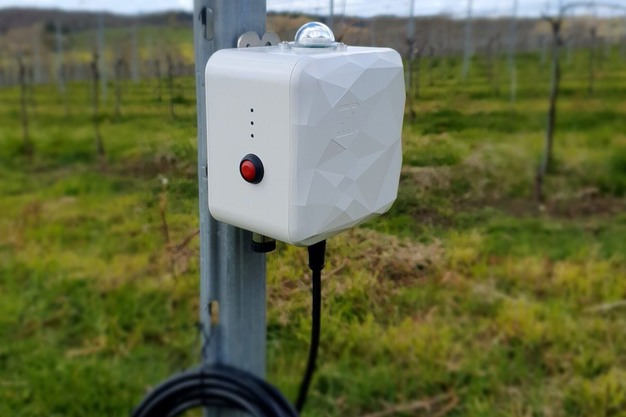Temperature, humidity, and multispectral light information. With this information, a grower knows a lot of what's going on in their facility. "But we often see the costs of upgrading your facility with such sensors are steep," says Gabriel De Franco with TerraPrima. "We hear from growers they have one sensor per 2.5 hectares. That's not representative of a growing facility." Their Ladybird sensor system, which integrates all three measurement devices, offers a durable, low-cost solution, making them accessible for tunnel growers as well.
Gabriel emphasizes the accessibility and longevity of the Ladybird sensors. "It's a solution that has a low entry barrier and is accessible to growers around the world. Initial investment is low, but it can last for a long time and gives the data capturing points you need to be able to successfully run a facility," he explains.

Light information
The Ladybird sensors capture not only temperature and humidity but also multispectral light information, allowing growers to fine-tune their lighting setups. As Ben Gillingham from TerraPrima elaborates, "Many sensor solutions capture temperature and humidity, but we also capture light, at a multispectral level. This way, you can see not only the total light your crop is getting, but what mix of light, which can make a huge difference to how the plant responds" This capability is particularly useful for growers using LEDs, enabling them to optimize light conditions for their crops.
However, information on the light in the greenhouse is not only of value to high-tech growers. "We work with many growers working under plastic, which degrades. This allows them to see the status and quality of their greenhouse foils." By monitoring the condition of greenhouse coverings, growers can make informed decisions about maintenance and replacements, ultimately protecting their crops and investment.
"At this stage, we know from talking to polytunnel manufacturers they've seen big degradation. The Ladybird multispectral light sensor will allow them to really understand what's going on," Ben says. This early feedback has been crucial in demonstrating the value of the sensors in real-world conditions.
Integration capabilities
One of the standout features of the Ladybird system is its integration capabilities, which allow users to expand beyond the 3-in-one sensor for light, humidity, and temperature. "It can be expanded with the same box to include anemometer, rain gauge, leaf wetness, and soil moisture," Gabriel mentions. This flexibility allows growers to create a comprehensive monitoring system tailored to their specific needs.
The system also supports a configurable alert system, sending SMS and email notifications if conditions exceed chosen thresholds. This feature provides growers with peace of mind, knowing they will be alerted in time to take action if necessary.
Yet, data is just data until you know how to work with it, which is why, along with the Ladybirds, comes an analyzing dashboard representing the data in a graphical and intuitive way to help growers understand what helps on the farm in graphs and values. "It does a bit of the work for a grower, analyzing the data in real-time."
Price point
"We know we're not the only sensor provider in the industry, but what we see is the price point often is high, resulting in limited numbers of sensors being installed," continues Gabriel. "One sensor per block is not enough to ensure stable crop production." As they are currently working on a rule of thumb, they would for now say four sensors per block are recommended. "Placing them at different light levels enables you to understand different crop lighting and informs you on where to start to adjust your light strategies."
This is why a lot of work went into the cost-friendliness of the system. "We design and manufacture our own sensors, owning the IP from end to end. This enables us to create a low-cost solution, as accurate as needed on farm level." For example, the sensors' robust design ensures long battery life, with units capable of running for 2 to 3 years on a single set of batteries, uploading data every few minutes. "This minimizes the need for frequent maintenance, reducing the overall cost of ownership," says Gabriel. "And if a sensor stops reporting for any reason, the grower is alerted."
Soft fruits, vineyards, and expanding
Currently, TerraPrima is working with various growers in the UK, focusing on soft fruits and vineyards. "We've worked with a number of growers in the UK. Our main target area: soft fruit, also on vines. Involved in a major project with one of the UK's leading growers," Ben reveals. The flexibility of the Ladybird system also shows promise in other agricultural sectors, such as citrus plantations in Morocco and various agroforestry applications.
As TerraPrima designs its own solution, they're fully committed to supporting the growers with ongoing product development. "We're continually trying to innovate, with a real focus on horticulture. The tools we're producing are tailored to what covered growers need," Ben asserts. This ongoing feedback loop with growers ensures that the Ladybird system evolves to meet the needs of the dynamic horticultural industry.
For more information:
TerraPrima
Gabriel De Franco
[email protected]
https://www.terraprimagroup.co.uk/
